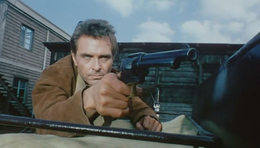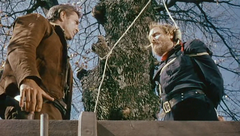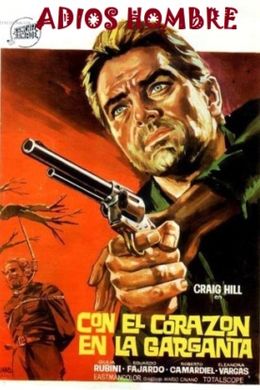Adios Hombre - Seven Pistols for a Massacre Review: Difference between revisions
No edit summary |
No edit summary |
||
| Line 38: | Line 38: | ||
The opening, with Craig Hill as a man desperately pleading his innocence, looks promising, but it takes quite a while before the movie delivers; actually only the finale lives up to the expectations created in the first minutes; in-between we get a rather odd hostage drama - a sort of Die Hard with a Vengeance spaghetti western style. On plot level a couple of unwise decisions are made: instead of having Hill stalking upon the villains, frustrating their efforts to locate and kill him, he's soon captured and tied to a pole in a stable, leaving director Caiano with a rather static premise. He tries to fill the time with some pointless brutalities and a couple of fistfights, one of them involving the local ballerinas, tired of being fought over by the horny bandits and taking matters into their own hands - or fists. It might well be the most ridiculous saloon brawl you'll ever see in spaghetti western. | The opening, with Craig Hill as a man desperately pleading his innocence, looks promising, but it takes quite a while before the movie delivers; actually only the finale lives up to the expectations created in the first minutes; in-between we get a rather odd hostage drama - a sort of ''Die Hard with a Vengeance spaghetti western style''. On plot level a couple of unwise decisions are made: instead of having Hill stalking upon the villains, frustrating their efforts to locate and kill him, he's soon captured and tied to a pole in a stable, leaving director Caiano with a rather static premise. He tries to fill the time with some pointless brutalities and a couple of fistfights, one of them involving the local ballerinas, tired of being fought over by the horny bandits and taking matters into their own hands - or fists. It might well be the most ridiculous saloon brawl you'll ever see in spaghetti western. | ||
{| align=right style="border:1px solid gray; padding:5px; margin:5px;" | | {| align=right style="border:1px solid gray; padding:5px; margin:5px;" | | ||
| Line 47: | Line 47: | ||
With this premise of a man who must try to prove his innocence, there are a few similarities to some of the early spaghetti westerns starring Giuliano Gemma, such as [[Adios Gringo]]. One of the titles, Adios Gringo, and the presence of Gemma's personal friend and regular antagonist Nello Pazzafini also seem to suggest that the project was set up as a Gemma vehicle, but as far as I know his name is never mentioned in relation to the movie. The film is saved by a couple of good performances, notably by Eduardo Fajardo as the mad gang leader, and Roberto Camardiel as his right hand, a criminal mastermind with a medical degree, who does the thinking while the boss himself is too busy shooting innocent bystanders. And then there's this finale, brief and sudden, with Flaherty and the sheriff (now on his side) using a nice stagecoach trick to surprise the bandits. | With this premise of a man who must try to prove his innocence, there are a few similarities to some of the early spaghetti westerns starring Giuliano Gemma, such as [[Adios Gringo]]. One of the titles, ''Adios Gringo'', and the presence of Gemma's personal friend and regular antagonist Nello Pazzafini also seem to suggest that the project was set up as a Gemma vehicle, but as far as I know his name is never mentioned in relation to the movie. The film is saved by a couple of good performances, notably by Eduardo Fajardo as the mad gang leader, and Roberto Camardiel as his right hand, a criminal mastermind with a medical degree, who does the thinking while the boss himself is too busy shooting innocent bystanders. And then there's this finale, brief and sudden, with Flaherty and the sheriff (now on his side) using a nice stagecoach trick to surprise the bandits. | ||
There are a few action scenes shot on location, but otherwise this is a town-bound western or even worse: large parts of it are set in and around the saloon. Spanish cinematographer Julio | There are a few action scenes shot on location, but otherwise this is a town-bound western or even worse: large parts of it are set in and around the saloon. Spanish cinematographer Julio Ortas frequently uses odd camera angles to give the film a more dynamic look and he does a relatively good job. Some of his compositions (look at the third screenshot) are quite inventive. According to most reference books the town scenes were all shot in the Elios studios, but I had the idea that another western town, less frequently called on by film makers, was used for a couple of scenes (otherwise this Julio Ortas even did a better job). The song performed by July Ray is way too serious and sorrowful for a western and no doubt composed for another type of movie. | ||
Revision as of 14:20, 4 May 2014
Adios Hombre - Seven pistols for a Massacre

|
Will Flaherty arrives in the town of Little Tucson (no doubt the twin town of Mini Hollywood) to see his girlfriend Peggy, a dancer in the local saloon. He was arrested for a bank robbery in which several bank employees were killed, but claims his innocence and says a man called Luc Brabham can clear his name. In the meantime a group of bandits, led by a murderous madman, take possession of the town: they have discovered that the safe of the bank is empty, and are now waiting for the next gold shipment to arrive. And then Will is told by Peggy that the man who can prove his innocence, has joined the bandits ...
The opening, with Craig Hill as a man desperately pleading his innocence, looks promising, but it takes quite a while before the movie delivers; actually only the finale lives up to the expectations created in the first minutes; in-between we get a rather odd hostage drama - a sort of Die Hard with a Vengeance spaghetti western style. On plot level a couple of unwise decisions are made: instead of having Hill stalking upon the villains, frustrating their efforts to locate and kill him, he's soon captured and tied to a pole in a stable, leaving director Caiano with a rather static premise. He tries to fill the time with some pointless brutalities and a couple of fistfights, one of them involving the local ballerinas, tired of being fought over by the horny bandits and taking matters into their own hands - or fists. It might well be the most ridiculous saloon brawl you'll ever see in spaghetti western.

|

|
With this premise of a man who must try to prove his innocence, there are a few similarities to some of the early spaghetti westerns starring Giuliano Gemma, such as Adios Gringo. One of the titles, Adios Gringo, and the presence of Gemma's personal friend and regular antagonist Nello Pazzafini also seem to suggest that the project was set up as a Gemma vehicle, but as far as I know his name is never mentioned in relation to the movie. The film is saved by a couple of good performances, notably by Eduardo Fajardo as the mad gang leader, and Roberto Camardiel as his right hand, a criminal mastermind with a medical degree, who does the thinking while the boss himself is too busy shooting innocent bystanders. And then there's this finale, brief and sudden, with Flaherty and the sheriff (now on his side) using a nice stagecoach trick to surprise the bandits.
There are a few action scenes shot on location, but otherwise this is a town-bound western or even worse: large parts of it are set in and around the saloon. Spanish cinematographer Julio Ortas frequently uses odd camera angles to give the film a more dynamic look and he does a relatively good job. Some of his compositions (look at the third screenshot) are quite inventive. According to most reference books the town scenes were all shot in the Elios studios, but I had the idea that another western town, less frequently called on by film makers, was used for a couple of scenes (otherwise this Julio Ortas even did a better job). The song performed by July Ray is way too serious and sorrowful for a western and no doubt composed for another type of movie.
How to watch it: There are two official releases, one German, one French. The German release is low cost but unfortunately also poor quality. The French DVD has good picture quality but is not English friendly. There are a few fandubs & fansubs floating around on the net. The English dub of this movie is rather poor, so the best way to watch it is no doubt in Italian with English subtitles.
--By Scherpschutter




